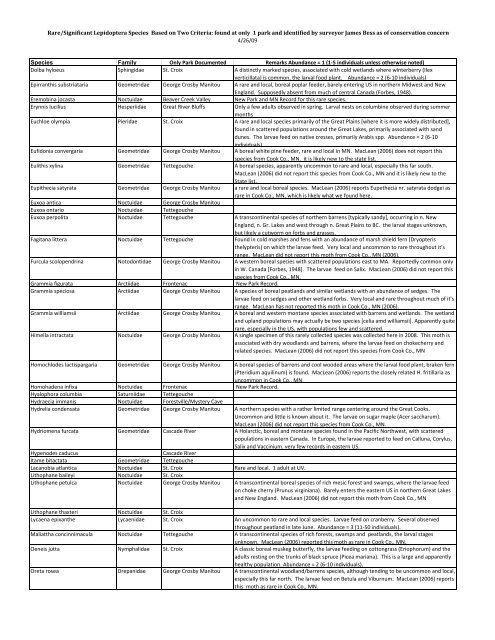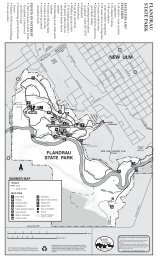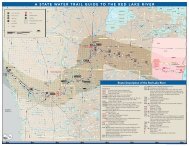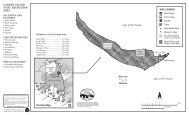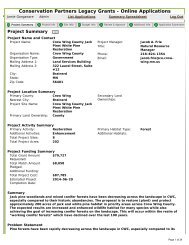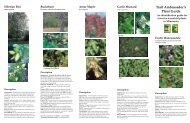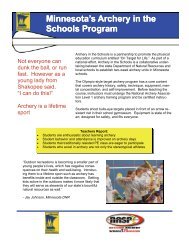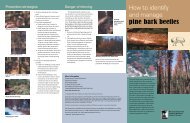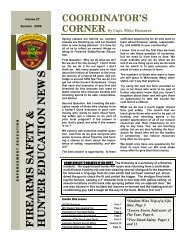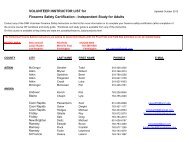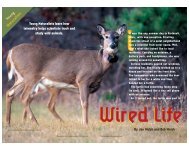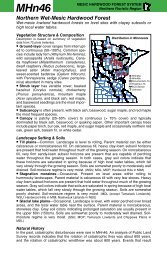A survey of Lepidoptera in three priority areas of the Minnesota state ...
A survey of Lepidoptera in three priority areas of the Minnesota state ...
A survey of Lepidoptera in three priority areas of the Minnesota state ...
Create successful ePaper yourself
Turn your PDF publications into a flip-book with our unique Google optimized e-Paper software.
Rare/Significant <strong>Lepidoptera</strong> Species Based on Two Criteria: found at only 1 park and identified by <strong>survey</strong>or James Bess as <strong>of</strong> conservation concern<br />
4/26/09<br />
Species Family Only Park Documented Remarks Abundance = 1 (1‐5 <strong>in</strong>dividuals unless o<strong>the</strong>rwise noted)<br />
Dolba hyloeus Sph<strong>in</strong>gidae St. Croix A dist<strong>in</strong>ctly marked species, associated with cold wetlands where w<strong>in</strong>terberry (Ilex<br />
verticillata) is common, <strong>the</strong> larval food plant. Abundance = 2 (6‐10 <strong>in</strong>dividuals)<br />
Epirranthis substriataria Geometridae George Crosby Manitou A rare and local, boreal poplar feeder, barely enter<strong>in</strong>g US <strong>in</strong> nor<strong>the</strong>rn Midwest and New<br />
England. Supposedly absent from much <strong>of</strong> central Canada (Forbes, 1948).<br />
Eremob<strong>in</strong>a jocasta Noctuidae Beaver Creek Valley New Park and MN Record for this rare species.<br />
Erynnis lucilius Hesperiidae Great River Bluffs Only a few adults observed <strong>in</strong> spr<strong>in</strong>g. Larval nests on columb<strong>in</strong>e observed dur<strong>in</strong>g summer<br />
months<br />
Euchloe olympia Pieridae St. Croix A rare and local species primarily <strong>of</strong> <strong>the</strong> Great Pla<strong>in</strong>s [where it is more widely distributed],<br />
found <strong>in</strong> scattered populations around <strong>the</strong> Great Lakes, primarily associated with sand<br />
dunes. The larvae feed on native cresses, primarily Arabis spp. Abundance = 2 (6‐10<br />
<strong>in</strong>dividuals).<br />
Eufidonia convergaria Geometridae George Crosby Manitou A boreal white p<strong>in</strong>e feeder, rare and local <strong>in</strong> MN. MacLean (2006) does not report this<br />
species from Cook Co., MN. it is likely new to <strong>the</strong> <strong>state</strong> list.<br />
Eulithis xyl<strong>in</strong>a Geometridae Tettegouche A boreal species, apparently uncommon to rare and local, especially this far south.<br />
MacLean (2006) did not report this species from Cook Co., MN and it is likely new to <strong>the</strong><br />
State list.<br />
Eupi<strong>the</strong>cia satyrata Geometridae George Crosby Manitou a rare and local boreal species. MacLean (2006) reports Eupe<strong>the</strong>cia nr. satyrata dodgei as<br />
rare <strong>in</strong> Cook Co., MN, which is likely what we found here.<br />
Euxoa antica Noctuidae George Crosby Manitou<br />
Euxoa ontario Noctuidae Tettegouche<br />
Euxoa perpolita Noctuidae Tettegouche A transcont<strong>in</strong>ental species <strong>of</strong> nor<strong>the</strong>rn barrens [typically sandy], occurr<strong>in</strong>g <strong>in</strong> n. New<br />
England, n. Gr. Lakes and west through n. Great Pla<strong>in</strong>s to BC. <strong>the</strong> larval stages unknown,<br />
but likely a cutworm on forbs and grasses.<br />
Fagitana littera Noctuidae Tettegouche Found <strong>in</strong> cold marshes and fens with an abundance <strong>of</strong> marsh shield fern (Dryopteris<br />
<strong>the</strong>lypteris) on which <strong>the</strong> larvae feed. Very local and uncommon to rare throughout it's<br />
range. MacLean did not report this moth from Cook Co., MN (2006).<br />
Furcula scolopendr<strong>in</strong>a Notodontidae George Crosby Manitou A western boreal species with scattered populations east to MA. Reportedly common only<br />
<strong>in</strong> W. Canada [Forbes, 1948]. The larvae feed on Salix. MacLean (2006) did not report this<br />
species from Cook Co., MN.<br />
Grammia figurata Arctiidae Frontenac New Park Record.<br />
Grammia speciosa Arctiidae George Crosby Manitou A species <strong>of</strong> boreal peatlands and similar wetlands with an abundance <strong>of</strong> sedges. The<br />
larvae feed on sedges and o<strong>the</strong>r wetland forbs. Very local and rare throughout much <strong>of</strong> it's<br />
range. MacLean has not reported this moth <strong>in</strong> Cook Co., MN (2006).<br />
Grammia williamsii Arctiidae George Crosby Manitou A boreal and western montane species associated with barrens and wetlands. The wetland<br />
and upland populations may actually be two species [celia amd williamsii]. Apparently quite<br />
rare, especially <strong>in</strong> <strong>the</strong> US, with populations few and scattered.<br />
Himella <strong>in</strong>tractata Noctuidae George Crosby Manitou A s<strong>in</strong>gle specimen <strong>of</strong> this rarely collected species was collected here <strong>in</strong> 2008. This moth is<br />
associated with dry woodlands and barrens, where <strong>the</strong> larvae feed on chokecherry and<br />
related species. MacLean (2006) did not report this species from Cook Co., MN<br />
Homochlodes lactispargaria Geometridae George Crosby Manitou A boreal species <strong>of</strong> barrens and cool wooded <strong>areas</strong> where <strong>the</strong> larval food plant, braken fern<br />
(Pteridium aquil<strong>in</strong>um) is found. MacLean (2006) reports <strong>the</strong> closely related H. fritillaria as<br />
uncommon <strong>in</strong> Cook Co., MN.<br />
Homohadena <strong>in</strong>fixa Noctuidae Frontenac New Park Record.<br />
Hyalophora columbia Saturniidae Tettegouche<br />
Hydraecia immanis Noctuidae Forestville/Mystery Cave<br />
Hydrelia condensata Geometridae George Crosby Manitou A nor<strong>the</strong>rn species with a ra<strong>the</strong>r limited range center<strong>in</strong>g around <strong>the</strong> Great Cooks.<br />
Uncommon and little is known about it. The larvae on sugar maple (Acer saccharum).<br />
MacLean (2006) did not report this species from Cook Co., MN.<br />
Hydriomena furcata Geometridae Cascade River A Holarctic, boreal and montane species found <strong>in</strong> <strong>the</strong> Pacific Northwest, with scattered<br />
populations <strong>in</strong> eastern Canada. In Europe, <strong>the</strong> larvae reported to feed on Calluna, Corylus,<br />
Salix and Vacc<strong>in</strong>ium. very few records <strong>in</strong> eastern US.<br />
Hypenodes caducus Cascade River<br />
Itame bitactata Geometridae Tettegouche<br />
Lacanobia atlantica Noctuidae St. Croix Rare and local. 1 adult at UV.<br />
Lithophane baileyi Noctuidae St. Croix<br />
Lithophane petulca Noctuidae George Crosby Manitou A transcont<strong>in</strong>ental boreal species <strong>of</strong> rich mesic forest and swamps, where <strong>the</strong> larvae feed<br />
on choke cherry (Prunus virg<strong>in</strong>iana). Barely enters <strong>the</strong> eastern US <strong>in</strong> nor<strong>the</strong>rn Great Lakes<br />
and New England. MacLean (2006) did not report this moth from Cook Co., MN<br />
Lithophane thaxteri Noctuidae St. Croix<br />
Lycaena epixan<strong>the</strong> Lycaenidae St. Croix An uncommon to rare and local species. Larvae feed on cranberry. Several observed<br />
throughout peatland <strong>in</strong> late June. Abundance = 3 (11‐50 <strong>in</strong>dividuals).<br />
Maliattha conc<strong>in</strong>nimacula Noctuidae Tettegouche A transcont<strong>in</strong>ental species <strong>of</strong> rich forests, swamps and peatlands, <strong>the</strong> larval stages<br />
unknown. MacLean (2006) reported this moth as rare <strong>in</strong> Cook Co., MN.<br />
Oeneis jutta Nymphalidae St. Croix A classic boreal muskeg butterfly, <strong>the</strong> larvae feed<strong>in</strong>g on cottongrass (Eriophorum) and <strong>the</strong><br />
adults rest<strong>in</strong>g on <strong>the</strong> trunks <strong>of</strong> black spruce (Picea mariana). This is a large and apparently<br />
healthy population. Abundance = 2 (6‐10 <strong>in</strong>dividuals).<br />
Oreta rosea Drepanidae George Crosby Manitou A transcont<strong>in</strong>ental woodland/barrens species, although tend<strong>in</strong>g to be uncommon and local,<br />
especially this far north. The larvae feed on Betula and Viburnum. MacLean (2006) reports<br />
this moth as rare <strong>in</strong> Cook Co., MN.


